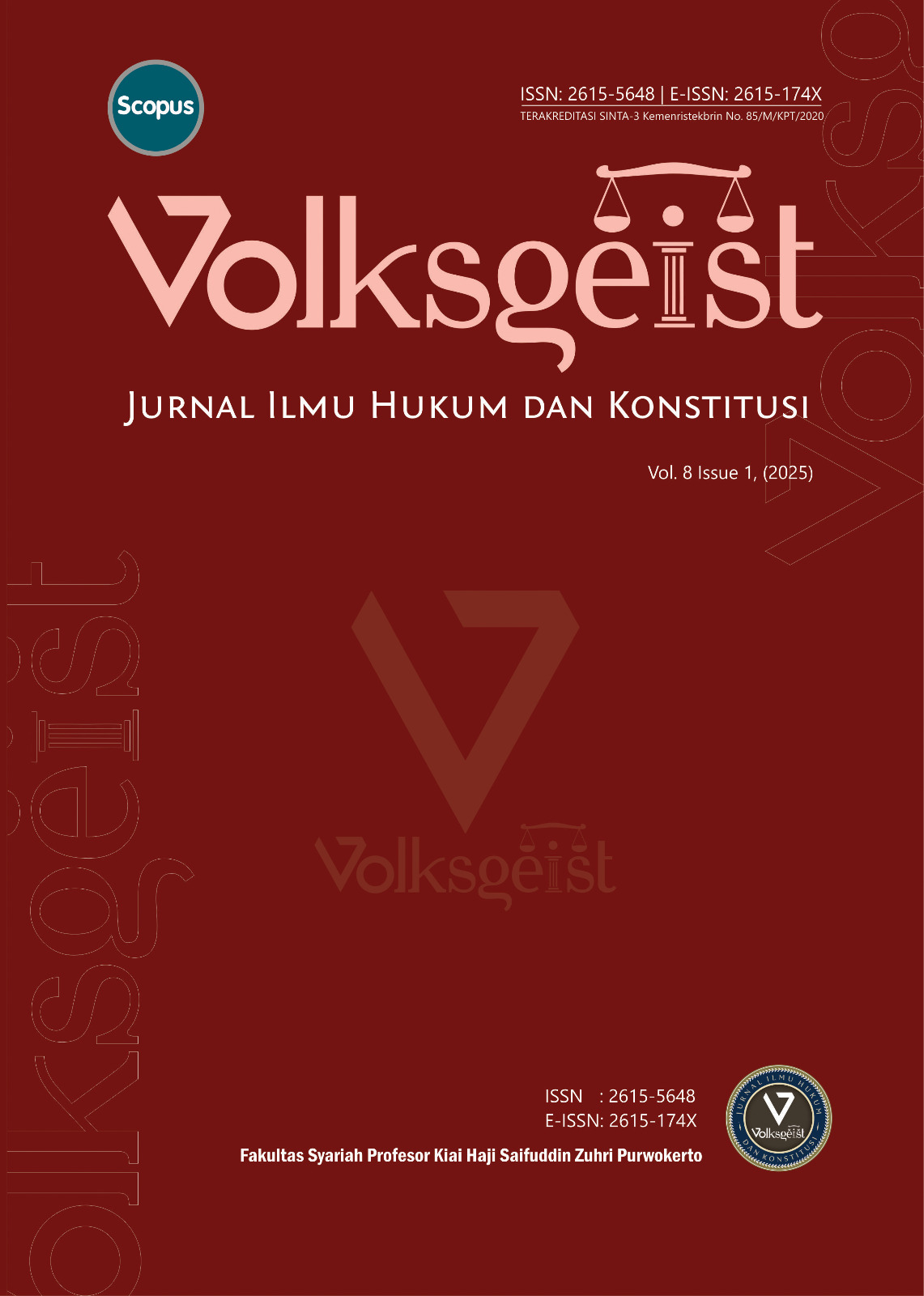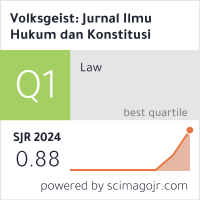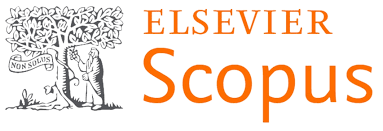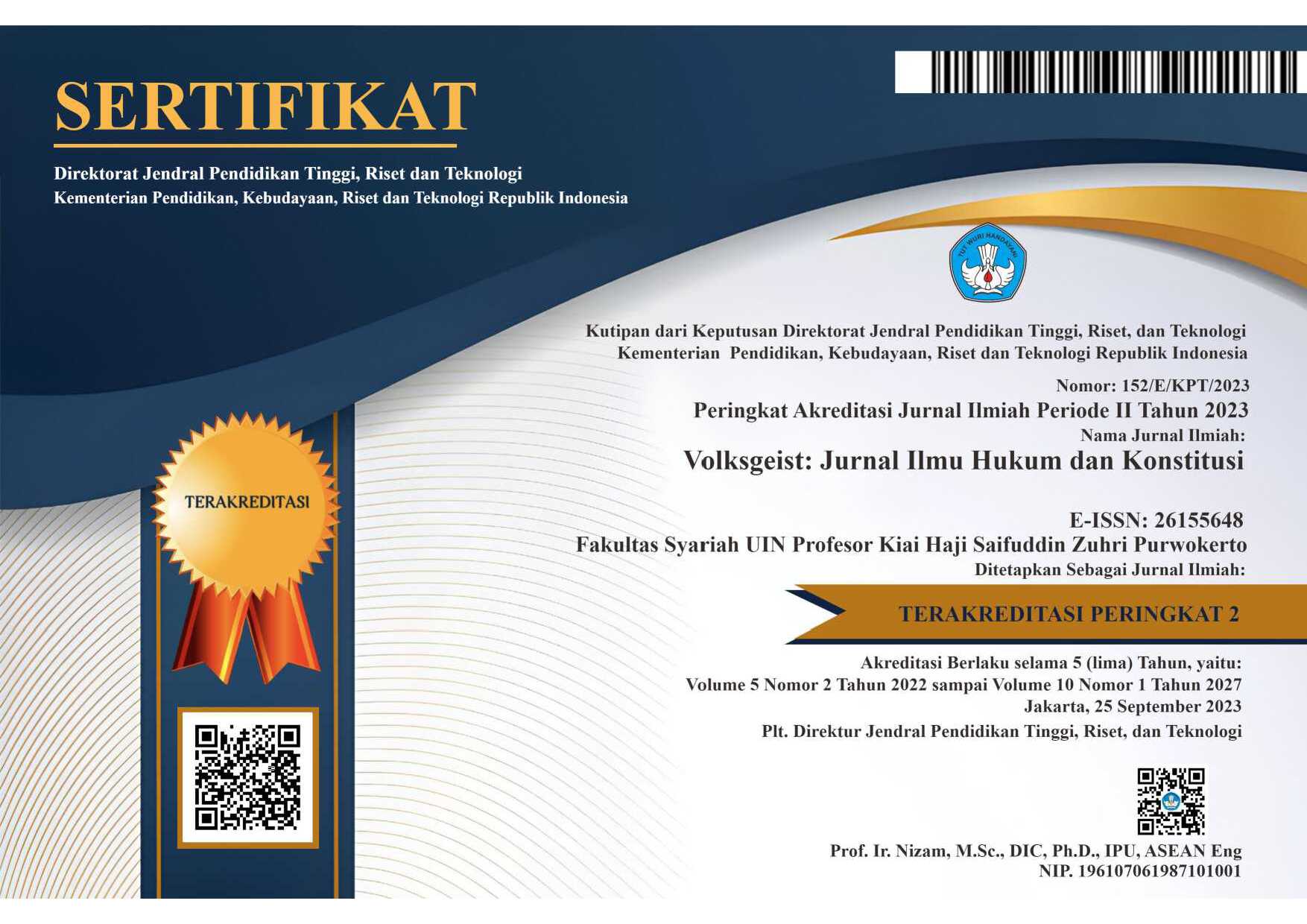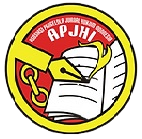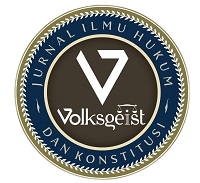The State's Responsibility in Preserving Local Culture: A Constitutional Law Perspective on the Practice of Akapalumba Jarangk
DOI:
https://doi.org/10.24090/volksgeist.v8i1.12334Keywords:
Akapalumba Jarangk; local tradition; cultural preservation; legal.Abstract
The state holds a fundamental responsibility to protect the human rights of its citizens, including the right to safety, as outlined in national constitutions and international law. Despite this, violations of these rights are often perpetrated by both state entities and non-state actors. This study aims to examine the state's role in safeguarding citizens' right to security, particularly in the context of human rights violations in Indonesia. Utilizing a normative juridical methodology that incorporates both statutory and case law analyzes, complemented by literature review, the research findings indicate that while national and international legal frameworks mandate the state to ensure citizen safety, actual implementation is inadequate. This is characterized by limited accountability and insufficient restitution for victims. Therefore, there is a pressing need for enhanced legal protection mechanisms and institutional reforms to ensure that the state's responsibilities are met and that the right to security is upheld as a fundamental aspect of human rights.Downloads
References
Adinugraha, Antonius Satria. “THE RIGHTS AND OBLIGATIONS OF THE STATE IN THE RESTORATION OF CULTURAL HERITAGE: A REVIEW ON INTERNATIONAL LAW AND THE PRACTICE OF INDONESIA.” Indonesian Journal of International Law 13, no. 4 (July 2016). https://doi.org/10.17304/ijil.vol13.4.666.
Adiprabowo, Vani Dias. “Cultural Communication in Wayang Sada and Preservation of Local Values.” Communicare : Journal of Communication Studies 11, no. 1 (2024): 66–77. https://doi.org/DOI: https://doi.org/10.37535/101011120245.
Airenti, Gabriella. “The Development of Anthropomorphism in Interaction: Intersubjectivity, Imagination, and Theory of Mind.” Frontiers in Psychology 9, no. NOV (2018): 1–13. https://doi.org/10.3389/fpsyg.2018.02136.
Akar, Murat, and Demet Kara. “The Formation of Collective, Political and Cultural Memory in the Middle Bronze Age: Foundation and Termination Rituals at Toprakhisar Höyük.” Anatolian Studies 70 (February 2020): 77–103. https://doi.org/10.1017/S0066154619000139.
Aksan, Nilgun, Buket Kısac, Mufit Aydın, and Sumeyra Demirbuken. “Symbolic Interaction Theory.” Procedia - Social and Behavioral Sciences 1, no. 1 (2009): 902–4. https://doi.org/10.1016/j.sbspro.2009.01.160.
Aldis, Abigail V. “Collective Memory: History, Memory, and Community,” 2020.
ALSUNAH, M D. “… OF LOCAL GOVERNMENT AND CUSTOMARY INSTITUTIONS IN CARRYING OUT THE PRESERVATION OF KENDURI SKO CULTURE IN THE TRADITIONAL ….” JURNAL ADMINISTRASI NUSANTARA, 2022. https://doi.org/DOI: 10.51279/jan.v5i1.563.
Amiruddin, Amiruddin, Asnandar Abubakar, Israpil Israpil, La Mansi, and Abdul Rahman Arsyad. “Strengthening Religious Moderationin Local Culture Through Community Leaders Perspectivein Jeneponto District.” In Proceedings of the 9th Asbam International Conference (Archeology, History, & Culture In The Nature of Malay) (ASBAM 2021), 2022. https://doi.org/10.2991/assehr.k.220408.087.
Andrews, Kristin. The Animal Mind: An Introduction to the Philosophy of Animal Cognition. Choice Reviews Online. Second. Routledge, 2015. https://doi.org/10.5860/choice.190486.
Artina, Dessy. “Government Policies in the Preservation of Malay Culture in Siak Regency, Riau.” Jambe Law Journal 4, no. 2 (November 2021): 217–35. https://doi.org/10.22437/jlj.4.2.211-230.
Carter, Michael J, and Celene Fuller. “Symbols, Meaning, and Action: The Past, Present, and Future of Symbolic Interactionism.” Current Sociology 64, no. 6 (October 2016): 931–61. https://doi.org/10.1177/0011392116638396.
Castillo-Huitrón, Nathalia M., Eduardo J. Naranjo, Dídac Santos-Fita, and Erin Estrada-Lugo. “The Importance of Human Emotions for Wildlife Conservation.” Frontiers in Psychology 11, no. June (2020): 1–11. https://doi.org/10.3389/fpsyg.2020.01277.
Clayton, Hilary M. “HORSE SPECIES SYMPOSIUM: Biomechanics of the Exercising Horse1.” Journal of Animal Science 94, no. 10 (October 2016): 4076–86. https://doi.org/10.2527/jas.2015-9990.
Clayton, Hilary M., and Sarah Jane Hobbs. “The Role of Biomechanical Analysis of Horse and Rider in Equitation Science.” Applied Animal Behaviour Science 190 (2017): 123–32. https://doi.org/10.1016/j.applanim.2017.02.011.
Davis, Dona Lee, and Anita Maurstad. “Meaning of Horses.” In The Meaning of Horses Biosocial Encounters, edited by Dona Davis and Anita Maurstad, 19. London: Routledge, 2016. https://doi.org/10.4324/9781315690728.
Gajewska, Grażyna. “Polymorphic Perversion of Human and Other-than-Human Bodies.” Porownania 31, no. 1 (2022): 277–93. https://doi.org/10.14746/por.2022.1.16.
Gane, Nicholas. “Book Review: Zygmunt Bauman Culture in a Liquid Modern World.” Sociology 46, no. 6 (December 2012): 1233–35. https://doi.org/10.1177/0038038512458377.
Hariyanto, Hariyanto, Ahmad Rezy Meidina, and Mabarroh Azizah. “Decentralization and the Fulfilments of Children’s Rights: Challenges and Opportunities for Local Government in Indonesia.” Lex Scientia Law Review 8, no. 2 (November 30, 2024): 677–706. https://doi.org/10.15294/LSLR.V8I2.14373.
Heerden, Willie Van. “Proverbial Wisdom, Metaphor and Inculturation 1 Willie van Heerden (Unisa).” Old Testament Society of South Africa (OTSSA), 1997. https://doi.org/10.10520/AJA10109919_733.
Junaid, Ilham, and Anne-Marie D’hauteserre. “The A’jarang Festival: An Innovative Effort for Regional Tourism Development in Jeneponto Regency (Indonesia).” Turizam 21, no. 4 (2017): 139–50. https://doi.org/10.5937/turizam21-16113.
Kartono, Kartono, Muhammad Fadilah, Aryuni Yuliantiningsih, and Anupriya Thakur. “Cultural Heritage Protection and Revitalization of Its Local Wisdom: A Case Study.” Volksgeist: Jurnal Ilmu Hukum Dan Konstitusi, September 2024, 245–61. https://doi.org/10.24090/volksgeist.v7i2.11281.
Maurer, Petra. “Humanizing Horses: Transitions in Perception and Perspective.” Religions 10, no. 6 (June 2019): 375. https://doi.org/10.3390/rel10060375.
Maurstad, Anita, Dona Davis, and Sarah Cowles. “Co-Being and Intra-Action in Horse-Human Relationships: A Multi-Species Ethnography of Be(Com)Ing Human and Be(Com)Ing Horse.” Social Anthropology 21, no. 3 (August 2013): 322–35. https://doi.org/10.1111/1469-8676.12029.
McManus, Phil, Glenn Albrecht, and Raewyn Graham. The Global Horseracing Industry. Routledge, 2012. https://doi.org/10.4324/9780203132432.
Moreira-Dias, Patrícia Luciana, Larissa Fernandes Franco, Maria Aparecida Bonelli, Esther Angélica Luiz Ferreira, and Monika Wernet. “Searching for Human Connection to Transcend Symbolisms in Pediatric Palliative Care.” Revista Brasileira de Enfermagem 76, no. 3 (2023). https://doi.org/10.1590/0034-7167-2022-0476.
Nurmiwati, Nurmiwati, and Fahidah Fahidah. “MAKNA UNGKAPAN TRADISIONAL DALAM MASYARAKAT BIMA.” Jurnal Ilmiah Telaah 3, no. 2 (October 2019): 123. https://doi.org/10.31764/telaah.v3i2.1229.
Panicker, Aswati, Kavya Basu, and Chia-Fang Chung. “Changing Roles and Contexts: Symbolic Interactionism in the Sharing of Food and Eating Practices between Remote, Intergenerational Family Members.” Proceedings of the ACM on Human-Computer Interaction 4, no. CSCW1 (May 2020): 1–19. https://doi.org/10.1145/3392848.
Pughe, Thomas. “Nature’s Social Union: Re-Reading Anthropomorphism in Poetry About Animals.” Caliban, no. 64 (October 2020): 283–307. https://doi.org/10.4000/caliban.9253.
Santoso, Joko, Atiqa Sabardila, Agus Budi Wahyudi, Rani Setiawaty, and Hari Kusmanto. “Membangun Karakter Siswa Sekolah Dasar Melalui Media Ungkapan Hikmah.” Al-Islam Dan Kemuhammadiyahan Multiprespektif, 2018, 65–75.
Self, Z. T., A. J. Spence, and A. M. Wilson. “Speed and Incline during Thoroughbred Horse Racing: Racehorse Speed Supports a Metabolic Power Constraint to Incline Running but Not to Decline Running.” Journal of Applied Physiology 113, no. 4 (2012): 602–7. https://doi.org/10.1152/japplphysiol.00560.2011.
Staudinger, Ursula M., and Judith Glück. “Psychological Wisdom Research: Commonalities and Differences in a Growing Field.” Annual Review of Psychology 62 (2011): 215–41. https://doi.org/10.1146/annurev.psych.121208.131659.
Suprihono, A E. “SAVING ‘JOGED MATARAM’ VIA YOUTUBE: PRESERVATION AND DISSEMINATION OF LOCAL CULTURE IN THE DIGITAL AGE.” International Journal of Humanity Studies (IJHS), 2022. https://doi.org/DOI: 10.24071/ijhs.v5i2.4304.
Taherdoost, Hamed. “What Are Different Research Approaches? Comprehensive Review of Qualitative, Quantitative, and Mixed Method Research, Their Applications, Types, and Limitations.” Journal of Management Science & Engineering Research 5, no. 1 (2022): 53–63. https://doi.org/10.30564/jmser.v5i1.4538.
Wang, Zhen Dong, Yi Meng Wang, Kang Li, Juan Shi, and Feng Yan Wang. “The Comparison of the Wisdom View in Chinese and Western Cultures.” Current Psychology 41, no. 11 (2022): 8032–43. https://doi.org/10.1007/s12144-020-01226-w.
Yue, Dan, Zepeng Tong, Jianchi Tian, Yang Li, Linxiu Zhang, and Yan Sun. “Anthropomorphic Strategies Promote Wildlife Conservation through Empathy: The Moderation Role of the Public Epidemic Situation.” International Journal of Environmental Research and Public Health 18, no. 7 (2021): 1–14. https://doi.org/10.3390/ijerph18073565.
Downloads
Published
How to Cite
Issue
Section
License
Copyright (c) 2025 Sahajuddin Sahajuddin, Reza Amarta Prayoga, Ansaar Ansaar, Abdul Hafid, Sritimuryati Sritimuryati, Entis Sutisna

This work is licensed under a Creative Commons Attribution-ShareAlike 4.0 International License.
Copyright Notice
Authors who publish with this journal agree to the following terms: Authors retain copyright and grant the journal right of first publication with the work simultaneously licensed under a Creative Commons Attribution-ShareAlike 4.0 International License that allows others to share the work with an acknowledgment of the work's authorship and initial publication in this journal.

